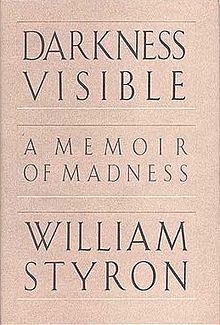- Darkness Visible (memoir)
-
Darkness Visible: A Memoir of Madness is U.S. writer William Styron's memoir about his descent into depression, and the triumph of recovery.
First published in December 1989 in Vanity Fair, the book grew out of a lecture that Styron originally delivered at a symposium on affective disorders at the Department of Psychiatry of Johns Hopkins University School of Medicine.[1]
The title of the work comes from John Milton's description of Hell in Paradise Lost:
- No light; but rather darkness visible
- Served only to discover sights of woe,
- Regions of sorrow, doleful shades, where peace
- And rest can never dwell, hope never comes
- That comes to all, but torture without end
- Still urges, and a fiery deluge, fed
- With ever-burning sulphur unconsumed.
Styron begins his story in October 1985 when he flies to Paris to receive the prestigious Prix mondial Cino Del Duca. During this trip the writer's mental state begins to deteriorate rapidly. Using a mix of anecdotes, speculation, and reportage, Styron reflects on the causes and effects of depression, drawing links between his own illness and that of other writers such as Randall Jarrell, Albert Camus, Romain Gary, and Primo Levi, as well as U.S. President Abraham Lincoln and activist Abbie Hoffman.
Styron connects the onset of his depression with his sudden termination of his lifelong alcohol use, and argues that his condition was likely exacerbated by careless prescription of the drug Halcion. His depression culminated in a bout of intense suicidal ideation (though he never made an actual suicide attempt), which led to hospitalization and recovery.[2]
References
External links
- James Patrick, "Darkness Visible by William Styron", CommonSense
Categories:- 1989 books
- Mood disorders
- Literary autobiographies
- Books by William Styron
Wikimedia Foundation. 2010.

